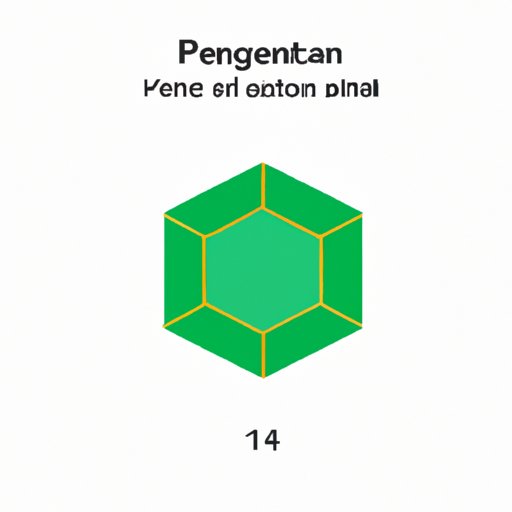
Introduction
In geometry, a pentagon is a five-sided polygon. It can be regular or irregular, with different side lengths and interior angles. Finding the area of a pentagon is an essential skill in math, architecture, art, and various engineering fields. Area is the amount of space the pentagon occupies in a two-dimensional plane. Once we have the area, we can calculate other properties of the pentagon, such as its perimeter or side lengths. In this article, we will learn how to find the area of a pentagon and explore its importance in solving real-life problems.
Step-by-Step Guide to Finding the Area of a Pentagon
Finding the area of a pentagon can be broken down into four simple steps. The following is a guide to follow:
- Determine the length of one side of the pentagon (let’s call it ‘a’)
- Calculate the apothem (‘r’), which is the distance from the center of the pentagon to its sides. The formula for apothem is: r = 0.5a x (1/tan(180/5))
- Calculate the perimeter (‘P’) by multiplying the length of one side by the number of sides: P = 5a
- Plug in ‘r’ and ‘P’ into the formula for the area (‘A’) of a regular pentagon: A = 0.5 x P x r
Here is an illustration of a regular pentagon, with each of its sides, apothem, and area labeled for clarity:

Importance of Understanding Pentagons and How to Find their Area
Learning how to find the area of a pentagon can be beneficial in many areas, including:
- Mathematics: Pentagons are a part of geometry and trigonometry, and the knowledge of their area can be used to solve equations and problems in these fields.
- Architecture: Architects use pentagons in designing structures with unique shapes and angles.
- Art: Pentagons are incorporated into various patterns and designs in art, such as the pentagon star and pentagon tiling.
- Engineering: Pentagons are used in designing objects and systems that require five symmetrical or balanced components.
Understanding pentagons and their area is also vital to broaden one’s educational knowledge and professional development. Knowing how to calculate the area of a pentagon can improve one’s problem-solving and critical thinking skills and lead to more opportunities for personal and career growth.
Discovering the Formula for Finding the Area of a Regular Pentagon
The formula for finding the area of a regular pentagon is:
Where ‘P’ is the perimeter of the pentagon, and ‘r’ is the apothem.
To calculate the perimeter (P) of a regular pentagon, multiply the length of one side (a) by the number of sides (n):
To calculate the apothem (r), use the following formula:
The derivation of the formula can be found using trigonometry and geometry. We can divide the pentagon into isosceles triangles, calculate their heights and bases, and then sum the areas of all five triangles to get the area of the pentagon.
Five Different Methods for Finding the Area of a Pentagon
There are various methods to find the area of a pentagon. Here are five different ways:
- Heron’s formula: This formula can be used to calculate the area of any polygon, including pentagons. It involves finding the semi-perimeter (s) and the lengths of the five sides of the pentagon. The formula is: A = sqrt(s(s-a)(s-b)(s-c)(s-d))
- Bisection: This method involves dividing the pentagon into triangles, finding their areas, and then summing them to get the area of the pentagon.
- Dissection: This method involves cutting the pentagon into smaller shapes, such as rectangles, triangles, and parallelograms, and then rearranging them to form a known shape whose area is easy to calculate.
- Trigonometric formulas: These formulas involve using trigonometric ratios to calculate the height and base of each isosceles triangle in the pentagon.
- Regular pentagon area formula: The formula we discussed above is specifically for regular pentagons, which have equal side lengths and angles.
Each method has its advantages and disadvantages, and the choice depends on the given information and the level of complexity of the problem.
Exploring Real-World Applications of Finding the Area of a Pentagon
The knowledge of finding the area of a pentagon has practical applications in many fields. Here are a few examples:
- Art: The pentagon star and pentagon tiling are patterns used in art and architecture.
- Architecture: Building facades and designs often feature pentagon shapes and angles.
- Engineering: In some cases, objects and machines may require five symmetrical or balanced components, such as wheels or gears.
- Science: The protein capsid of some viruses has a pentagonal shape, which can help scientists understand the virus’s properties and replication mechanisms.
Real-life problems that involve pentagon area calculation can be solved using any of the methods we discussed above. For instance, in architecture, calculating the area of a pentagon-shaped roof can help determine the amount of material needed to construct it. In science, calculating the area of a pentagonal protein can help estimate its volume and mass and understand its interactions with other molecules. By understanding how to calculate the area of a pentagon, we can apply this knowledge to solve real-life problems and make informed decisions in various fields.
Conclusion
Finding the area of a pentagon is a fundamental skill in math, architecture, art, engineering, and sciences. It is calculated using the formula A = 0.5 x P x r, where ‘P’ is the perimeter and ‘r’ is the apothem. Other methods such as Heron’s formula, bisection, and dissection can also be used to find the area of a pentagon. Understanding pentagons and their areas is essential for personal and professional development and can lead to opportunities for creative applications and problem-solving in different fields.
Therefore, we encourage you to practice using the methods discussed in this article and continue learning about the importance of pentagons in different domains.




